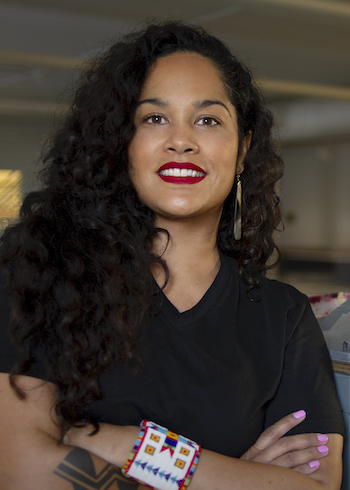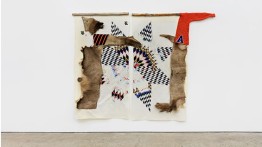Natalie Ball Awarded 2020 Ida Applebroog Grant by School of Art
POSTED ON: June 1, 2020
The Cooper Union School of Art has announced that the 2020 Ida Applebroog Grant has been awarded to multidisciplinary artist Natalie Ball. The juried $10,000 award is given to an under-recognized artist whose work demonstrates high artistic merit while consistently challenging artistic conventions. Painter Cheyenne Julien received honorable mention.
Natalie Ball uses painted textiles and sculptures to create a visual genealogy to disrupt the mainstream definition of Indian. Through a lens of auto-ethnography, she aims to challenge mainstream ideas of Indigeneity, using her own family history to bring forward legacies, intersections, histories, and experiences that reflect the complexity of Native American lives. A Klamath Tribes citizen, Ball is a descendant of Captain Jack (1837–1873), the leader who led the Modoc people against the United States army in the 1872 Modoc War and who was tried and executed as a war criminal by a jury made of US soldiers. She plans to use the Ida Applebroog grant to further research oral histories, community and museum archives on the colonial history of the execution and display of the criminal body through gibbeting.
gibbeting.
“The Ida Applebroog Grant will help the progression of my practice with new research and informed materiality,” says Ball. “I will continue to challenge historical discourses that have constructed a limited and inconsistent visual archive that currently misrepresents our past experiences and misinforms current expectations. Mo sepkecha, I am honored for the opportunity to carry the Ida Applebroog Grant on my journey.”
“I'm grateful to our nominators and review panelists for selecting an artist who perfectly exemplifies the criteria of the Ida Applebroog Grant,” says Mike Essl, Dean of The Cooper Union School of Art. “Ball's work is compelling in form and in its complex engagement with Indigeneity, and The Cooper Union is excited to see Ball receive this recognition and support at this moment of her career.”
Born and raised in Portland, Oregon, Natalie Ball received an M.F.A. in painting and printmaking from Yale School of Art in 2018 and a M.A. in Māori Visual Arts from Massey University in 2010. Ball has held solo gallery shows at in the Seattle Art Museum, Seattle, WA; PDX Contemporary Art, Portland, OR; EXPO Chicago, Chicgao, IL; Half Gallery, New York, NY; and more. She has received a Pollock-Krasner Foundation Grant, Pollock-Krasner Foundation; Bonnie Bronson Visual Arts Fellowship, Oregon Community Foundation; and The Betty Bowen Award, Seattle Art Museum, among others.
Named for artist Ida Applebroog whose work explored gender and sexual identity, politics, and violence, the Ida Applebroog Grant was originally issued by Exit Art. Following Exit Art’s close, The Cooper Union was asked to steward the biennial award which comes with an unrestricted $10,000 that can be used to assist in the development of the selected artist’s practice. This is the first year that the School of Art is issuing the award since Exit Art’s closure. Review committee members included artists and curators Chloë Bass, Pradeep Dalal, Sara Reisman, Dread Scott, and Martha Wilson.








